Dr. Mohamed Elsanousi is the new Executive Director for the Network for Religious and Traditional Peacemakers.
The Network’s leadership appointed Dr. Mohamed Elsanousi as the new Executive Director on May 1, 2018. The appointment was announced at the 8th Advisory Group Meeting for the Network for Religious and Traditional Peacemakers in Stockholm on May 4-6, 2018.
Since its inception in 2013, the Network for Religious and Traditional Peacemakers has grown from a small UN-led initiative to a coalition of over fifty organizations working together to build bridges between grassroots-level peacemakers and global players in order to strengthen international efforts to build sustainable peace.
During the four-year tenure of former Executive Director Antti Pentikäinen, the Network made significant strides toward fulfilling its mandate to collaboratively support the positive role of religious and traditional actors in peace and peacebuilding processes.
“As we begin this new chapter of our work, I am delighted to see Mohamed Elsanousi step into the Executive Director role, and I look forward to supporting him as he guides the Network into the future,” says Pentikäinen, who will lead the Network working group on reconciliation. This includes research on the impact of reconciliation with Princeton University and the Center for Theological Inquiry.
Dr. Elsanousi has been with the Network since 2014 and previously served as the Director of the Network’s Washington, DC office.
“I am humbled by the appointment and the trust the leadership has shown me. I am thrilled to continue building on what we have already achieved together and crafting a clear and inclusive strategy to further localize the efforts of religious and traditional actors to build peace in the most challenging contexts”, he says.
Dr. Elsanousi’s selection as the Executive Director was also welcomed by the Network’s UN partners.
“As the UN redoubles its commitment to working with religious actors to address some of the most pressing challenges facing their communities, we are thrilled to strengthen and expand our partnership with the Network, with Dr. Elsanousi at its helm,” said H.E. Adama Dieng, Under-Secretary-General and Special Adviser of the Secretary-General on the Prevention of Genocide.
Dr. Azza Karam, Senior Advisor on Culture at the United Nations Population Fund, echoed these sentiments.
“Dr. Elsanousi’s reputation as a strategic convener of diverse actors, a responsible manager of interreligous and intercultural service for peace, and a leader confident in recognizing and building on the achievements of those who went before him, positions him very well to take the Network forward in the years to come.”
As the Secretariat of the Network since 2013, Finn Church Aid also expressed its wholehearted support and enthusiasm for the appointment.
“It has been great to witness the vigor and drive with which the new Executive Director has taken on his role. Mohamed is known for his broad personal networks and networking capacity, which will be a significant asset as the Network continues to grow,” notes Jouni Hemberg, Executive Director of Finn Church Aid.
Dr. Elsanousi’s appointment was announced at the Network’s 8th Advisory Group Meeting on May 4. Drawing on the evaluation concluded in March, the meeting focused on discussions on further development of strategy and structure.
“The evaluation offered concrete recommendations, and Dr. Elsanousi made it clear he will make good use of them as he continues the further development of the Network. The Network is solidifying its position as a significant partner to the international community and will continue to build on models that have proven useful,” says Tomi Järvinen, Director of International Cooperation at Finn Church Aid.
Finn Church Aid (FCA) founded The Network for Religious and Traditional Peacemakers in 2013 at the UN’s request and has since hosted the Network’s secretariat. Read more about the Network here.
Violent extremism contributes to some of the world’s worst humanitarian catastrophes. It also poses a challenge to the gains in development enjoyed by many countries in Africa, a new report concludes.
The typical extremist organisation recruit is a 17–26-year-old from a state’s poorest, peripheral areas with only a few years of secular education and a low level of religious literacy. At the time of joining, the recruit’s main concern in life is employment. His or her confidence in institutions and governance is limited.
This is one of the main conclusions of the UN Development Program UNDP’s extensive report, launched in Helsinki on Friday 4th of May. The Journey to Extremism report sheds new light on the path to radicalisation and on how the effects of violent extremism hampers humanitarian work and development cooperation. (Download the full report in pdf-format here.)
Researchers conducted interviews with 718 people from Somalia, Nigeria, Kenya, Sudan, Niger and Cameroon – the largest sample of interviews with former members of extremist groups thus far.
With the above-mentioned preconditions, a recruit only needs to reach a “tipping point” before making the final decision to join an extremist group. In 71 percent of the cases, the defining event consists of a government action, often an excessive security response against a perceived terrorist threat.
The decision to join is quick, says Mohamed Yahya, lead author of UNDP’s research. Some 80 percent join an extremist group within a year after the tipping point, and a striking 48 percent within less than a month.
“This emphasises the fact that development solutions are essential in addressing the incentives and drivers of violent extremism. Military solutions are not enough”, Yahya concludes.
Research in sync with FCA’s key findings
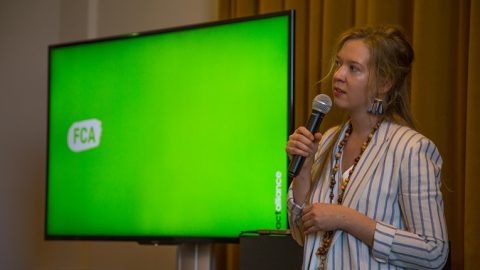
FCA’s Reach Out coordinator Milla Perukangas providing perspectives on preventing violent extremism in Finland. Photo: Rabbe Sandström
The destructive consequences of violent extremism have resulted in 33 300 fatalities in Africa between 2011 and 2016, not to mention the devastating effects related to displacement and economy.
Extremism-related research has thus far largely been the territory of organisations working with security issues, although the issue profoundly affects development actors, says Yahya. It threatens to stunt development outcomes for generations to come if left unchecked.
“How can you talk about sustainable development goals and women’s rights when the question for many is whether they dare to go to the market and take the risk to be blown up”, Yahya says.
Almost 80 percent of the interviewees had previous connections to the extremist groups Boko Haram and al-Shabaab, which Finn Church Aid’s (FCA) previous research has focused on. UNDP’s research is in line with FCA’s previous findings, for instance that family and friends – not religious leaders – recruit most members.
(Read more about FCA’s research on al-Shabaab by clicking here and about Boko Haram by clicking here.)
Yahya highlights the role of local voices as a counterbalance to the influence of extremist groups, especially the role of religious leaders, which is one of the key groups supported by FCA’s peace work.
“But we also need to create viable exit paths, which include opportunities created by development in these poor peripheral areas”, Yahya says and adds that current circumstances do not contain enough options.
“Like one of our interviewees said: ‘After I left Boko Haram, I was welcomed by poverty’.”
Trust is key in preventing violent extremism
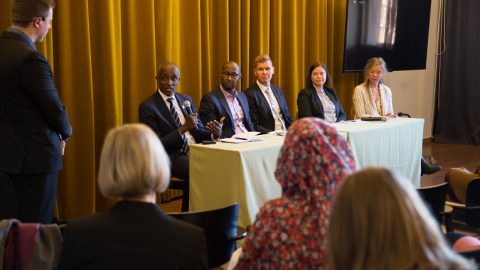
Panel discussion on preventing violent extremism, held at the UNDP’s report launch in Helsinki on May 4th. From the left UNDP’s Africa Regional Programme Coordinator Mohamed Yahya, Arshe Said from the Finnish Somali League, David Korpela from the Finnish Ministry for Foreign Affairs, Katja Creutz from the Finnish Institute of International Affairs and Milla Perukangas, FCA’s Reach Out coordinator. Photo: Rabbe Sandström
The question of how to prevent youth from joining extremist groups is a question for the whole society, says Milla Perukangas, coordinator for FCA’s Reach Out project against violent extremism in Finland. FCA has put its international experience and knowhow of preventing violent extremism in use in Finland since 2015 as a response to the vast number of foreign fighters traveling from Europe to conflict zones.
The solutions are always context-specific, but there are universal keywords that are applicable in all circumstances. Trust is one of them, says Perukangas. The Reach Out project has specialised in building bridges between those at risk of recruitment, their families, civil society actors and Finnish authorities.
“We need to empower youth through for instance education and opportunities to both speak their mind and find employment”, Perukangas said in her presentation at the report’s launch event in Helsinki.
“In the long run, the work to prevent violent extremism needs more emphasis on the human experience and the initial grievances of people in affected areas.”
Text: Erik Nyström
Download the full UNDP report The Journey to extremism in pdf-format by clicking this link. Read more about FCA’s research on al-Shabaab by clicking here and about Boko Haram by clicking here. Read more about the Reach Out project here.
There are anniversaries for humanitarian workers that are sad reminders of evil in the world. This week marks the seventh year of the Syrian war, and this is no cause for celebration. There is just a cruel war in which all parties have lost a long time ago.
Last week, I was in Syria for a project monitoring trip, and the war was constantly present. The war could even be seen in areas that have not had violent conflicts. In addition to visible fights, 6.1 million internally displaced persons place a burden on the economy of more peaceful areas and on public services.
The war affects the life of every Syrian.
During my trip, I met with colleagues over breakfast in the mornings, and I listened in silence as they talked about the friend or relative in Damascus whose house had been hit by a rocket and whether anyone had been killed or injured. I was shaken by how everyday these stories sounded coming from them and how tired they are after seven years of war.
We were supposed to go to Damascus, but it is impossible at the moment. The fighting in Eastern Ghouta is at its most heated, and dozens of rockets and grenades are fired at the city every day. On my last visit in the fall of 2017, the streets were full of people in the evenings. Single projectiles did not hold people back. Now, in March, people think it best to stay at home.
The Syrian war is a shameful example of the failure of great powers
As humanitarian operators, we do not publicly take sides in politics, but I have to say that seven years of war in Syria is a shameful example of the failure of political will and decision-making on the part of great powers. In the midst of this political tug-of-war, the one to suffer most is always the human being, whichever side of the front line he or she lives.
The victim has been an entire nation, especially children. There is a whole generation of refugees in Syria’s neighbouring countries that has never lived in their native land. At Za’atari refugee camp in Jordan, 80 Syrian children are born as refugees every week. They grow up within the walls of refugee camps and in the poor quarters of a foreign land.
Seven years have left behind unimaginable destruction and human suffering. Hundreds of thousands have died, and in addition to internally displaced people, 5.6 million refugees have fled to neighbouring countries. The real number is much higher, since not everyone has been registered.
There are glimmers of light in Syria, as some get to return to their homes and are able to restart their lives. However, the overall situation for civilians is worse than ever.
69 percent live in extreme poverty. The price of food is eight times higher than before the war. 5.6 million people live in a life-threatening situation, without shelter, protection, and unable to meet fundamental rights or basic needs.
These people are in need of immediate humanitarian aid, and fast, but it cannot be easily delivered everywhere, as is the situation in Eastern Ghouta right now.
Functioning washrooms mean more pupils
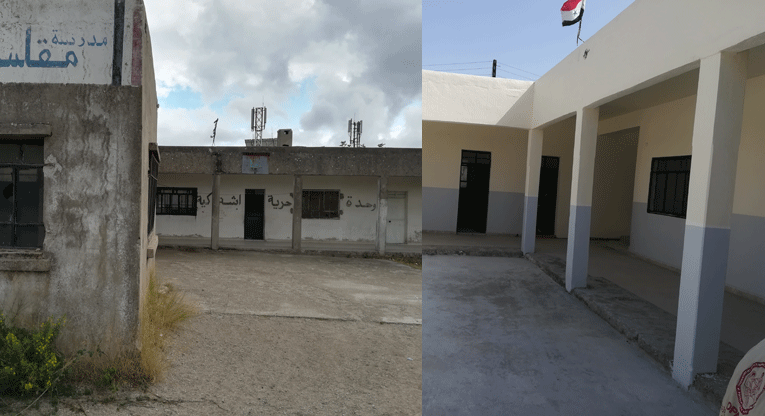
Muqlos school in rural Homs in October 2017 (left) and after the rehabilitation in March 2018. Photo: Olli Pitkänen.
Finn Church Aid has supported children’s opportunities for going to school and the restoration of school buildings since 2015. Even though children’s access to school has improved in recent years, 1.7 million school-aged children, or 43 percent, are still out of school.
The need to get children to school is enormous in both Syria and neighbouring countries.
This winter, Finn Church Aid supports the restoration of 12 schools in central Syria. Classrooms, washrooms, and water stations are renovated, walls are painted, and desks are repaired.
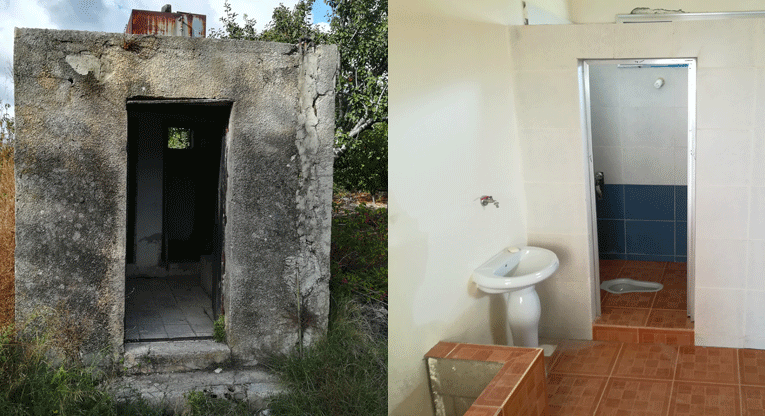
Washroom and toilet of Muqlos school in rural Homs area in October 2017 and in march 2018. Photo: Olli Pitkänen.
We visited ten schools, and many children of internally displaced people study in each of them. At the Tartus countryside, principal of Muniat ya Mor school Hamsa Ali says with gratitude that renovating the school meant a lot to the community.
”Before, the toilets did not work and there was no water. Now they are in really good condition. The renovated school facilities have lured the children back to school,” said Ali during my visit.
Joyful colours on the classroom walls have already improved learning results. Absences have dropped, and fewer children and young people than before drop out of school. Teachers’ motivation has improved.
Teaching and learning are appreciated again!
Yusra Naser school in Safita has 361 pupils, 81 of whom the children of internally displaced people. English teacher Lucy Vitar believes there is a bright future ahead for the students.
”They are sad because of the war. Many of them are really bright, and we hope that they learn to love studying,” says Vitar regarding the significance of the renovation work.
Maintaining hope is important everywhere. The desire to believe in a brighter future makes people work for the common good. This could be felt in all the schools.
Principal of Nadim Resla school in Latakia, Fateer Barhom, summed up the effects of the seven years of war in a way I found apt. Although the war has affected everyone, adults need to be able to take responsibility for the children and create the best possible circumstances for them to study in.
Children deserve a chance to build their life in a safe environment.
Olli Pitkänen
Development Manager, Middle East, FCA
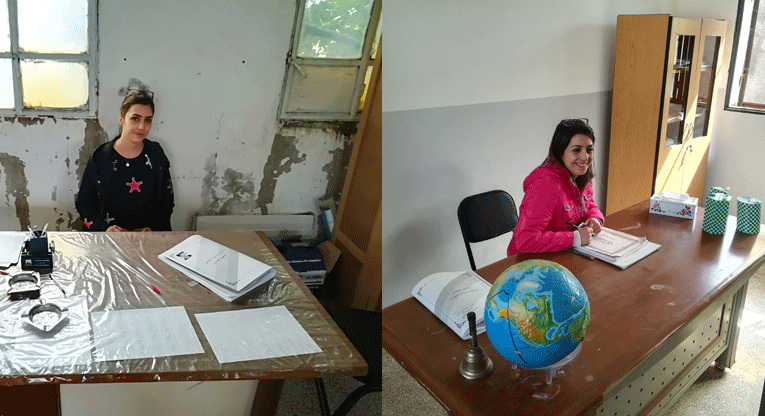
The office of principal Noura in Muqlos school in October 2017 and March 2018. The reconstruction of schools gives hope of a brighter future and motivates also the teachers. Photo: Olli Pitkänen.
In South Sudan, the price of food claims people’s lives as well as guns. Hunger staggers society, with people only focused on where to get their next meal.
When you throw a seed in the ground, it grows into a giant mango tree.
This is a saying from South Sudanese Equatoria, the breadbasket of the country. The soil is so fertile that crops grown in the region have fed millions of South Sudanese people. Practically all of South Sudan is a perfect seedbed for produce such as rice, corn, millet, sugar cane, and fruits.
However, war has driven three quarters of the region’s population out of their homes, and vast cultivated areas stand abandoned, says Marie Makweri, who worked in South Sudan for three years as Finn Church Aid’s (FCA) peace coordinator.
The dramatic consequences are seen in the availability and prices of food products. People are lucky to have even one meal a day. Anyone knows that hunger makes a person ill-tempered. Hunger makes the prolonged conflict even worse.
”People in South Sudan say that there are more weapons than food, which is a dangerous combination. A person with no food to feed oneself or one’s family thinks of all the ways in the world to get food,” says Makweri.
5 million people still on the brink of famine
In February 2017, UN declared a famine in Unity State, located in the middle of South Sudan. About 100,000 people were in danger of starving to death. The declaration was followed by an extensive humanitarian operation, during which food ration packages were dropped in the region from World Food Program (WFP) helicopters. FCA contributed to the food aid from its disaster fund.
In June, the famine was officially over, but the daily life of the South Sudanese people did not improve in any significant way. For famine to be declared, the situation has to meet clearly defined criteria. First, a fifth of households must suffer from an extreme lack of food, and a third of the population must be acutely malnourished. In addition, people die at a certain rate – the definition of famine calls for two victims per day for every 10,000 inhabitants.
Famine is equivalent to the highest category on a UN scale of 1 to 5 measuring food security. The current situation does not meet the criteria. On the other hand, 1.5 million people live in a state of emergency (stage 4) and 3.6 million in acute food shortage (stage 3). In other words, there are 5 million South Sudanese people on the brink of famine.
”When you’re there observing the situation, it makes no real difference if people are at stage 4 or 5. The food situation remains extremely difficult”, says Makweri.
Food prices increased tenfold
FCA supports peace and food security
FCA supports peace processes, education and opportunities for subsistence in South Sudan. FCA trainings teach skills such as baking and handling food and dairy products, which improves food production.
Since last fall, FCA has carried out a food security project with 100,000 euros from a disaster collection. The project involves farming training for 500 farmers, and participants in the training are provided with seeds and tools.
The South Sudan food crisis is the result of a prolonged conflict. The conflict began as a power struggle between president Salva Kiir and former vice president Riek Machar. The rivalry turned into war with ethnic battle lines. Kiir represents the Dinka tribe, the biggest tribe in South Sudan, and Machar is from the Nuer tribe, the second biggest.
The conflict is rooted in a dispute over resources after South Sudan gained independence in 2011 – land ownership, water, and oil. Kiir accused Machar of an attempted coup and dismissed him. There are other tribes in South Sudan as well, coaxed into alliance or played against each other. In the autumn of 2016, UN issued a warning of a possible genocide.
Fear has had catastrophic repercussions on food production. Farmers are too afraid to sow or harvest their crops. Food deliveries have become difficult, and prices at marketplaces have risen sky-high. After the fighting that started in July 2016, the price of a 3,5-kilo sack of maize meal in the capital Juba rose from 5,5 euros to 60 euros. The price is equivalent to a month’s average wages in South Sudan.
Even the prices of basic vegetables, such as tomatoes, have increased tenfold, and further from the capital, prices are even higher. Tea, sugar, and meat are luxury products that have become completely nonexistent.
The effects are seen on the street, says Makweri, who lived in Juba up until the turn of the year. Shopkeepers cannot afford to buy expensive food products and sell them at a profit, so many grocery stores have closed. Even bigger marketplaces have less items to sell, and fewer and fewer vendors selling them.
”Ordinary people can’t afford food,” says Makweri.
Food aid keeps people sane
In her work, Makweri has seen people’s preoccupation with food. Motivating them to participate in peace processes takes patience when their foremost concern is where to get the next meal for their family.
”People find it hard to even think about the next day, let alone the long-term effects of peace. They’re thinking about the next minute that they might as well use to get food.”
On the other hand, the food situation will not improve in any significant way until the conflict ends. South Sudan has all the prerequisites for self-sufficient food production, provided that peace can be achieved in the country. Food aid supported by the international community is keeping the negotiations alive.
”The message of the South Sudanese people is unanimous: the food aid should under no circumstances be discontinued. It keeps people alive and sane, and literally gives the strength to believe in peace.”
Text: Erik Nyström
Read more about about Finn Church Aid’s work in South Sudan here.
The greatest fear of Muja Rose, a refugee from South Sudan, is that her daughter will starve to death. Uganda is at a breaking point in the throes of the biggest refugee crisis in Africa since the Rwanda genocide.
The children were playing when war found the family of 34-year-old Muja Rose in South Sudan.
Government soldiers arrived without warning in their hometown of Kajo Keji. They were immediately caught by surprise by a group of rebels. People were killed and their possessions were looted.
Rose’s husband was away, and in the crossfire, Rose made the toughest decision of her life.
”The only alternative was to run as fast as my feet would carry. I decided to take the children to Uganda,” says Rose.
Rose managed to take her own four children as well as two children who had lost their mother with her. She carried the youngest one on her back through the bush and stayed up all night to protect the children from wild animals. They had no food or water.
”The children were crying out of hunger and exhaustion. When we found a dry streambed, I tried to dig for water in the ground to have drinking water for the children.”
Food is a constant preoccupation
A year later, all the children are seated around a clay oven in the Bidibidi refugee settlement. The area, the size of Turku, has 290,000 inhabitants, which would make it the second biggest city in Finland after Helsinki.
The clay oven is located in the only shaded spot in the yard, and attracts others to seek shelter from the relentless sun. The aroma from the sizzling pot is familiar from any kitchen in the world: fried onions.
Rose chops a few eggplants from her vegetable garden and adds them to the pot, with 10-year-old Ayite stirring the stew.
”Once a week we cook eggplants, once okra, once vegetables. The remaining days we eat beans,” says Rose.
”The food has no variety and the children are sick all the time. They’re not getting all the vitamins they need.”
Food is constantly on Rose’s mind. Even though the demanding journey to Uganda has reduced the risk of becoming victim to bullets or rape, life is a taxing struggle to meet basic needs. She is not alone in this situation.
Over a million people from South Sudan have crossed the border to Uganda, almost all of them after July 2016.
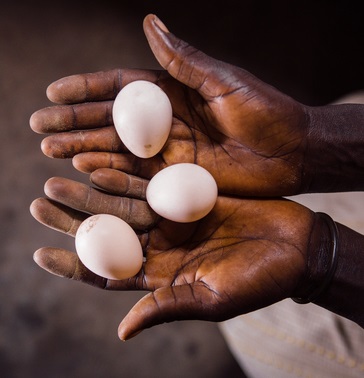
Some refugees are lucky to have chicken that produce eggs. Most, like Muja Roses family, have left behind all their possessions when fighting broke out. Photo: Tatu Blomqvist
Taking care of the crisis costs about 560 million euros per year, but the international community has only met a third of the need. According to the UN, Uganda is at a breaking point. The refugees most feel this in the food rations that have been halved twice, says Bik Lum, regional head of UN refugee agency UNHCR.
The food aid delivered monthly includes beans, vegetable oil, salt, and maize meal. At the end of last year, the maize meal rations were cut from 12 kilos to 6 kilos per person.
”Some have risked their lives and gone to South Sudan to look for food in their abandoned homes,” says Lum.
One meal a day
Uganda, a country smaller and poorer than Finland, has despite its limited resources admitted all refugees into the country.
The Ugandan refugee policy is praised as forward thinking in the western world, since among other things, it guarantees everyone a piece of land to live on and cultivate. This does not mean that life in refugee settlements feels meaningful.
More land has continuously been cleared from previously unliveable bush, and growing things to eat is hard.
Rose’s yard is rocky, but as a woman with green fingers, she has managed to grow something. So has Wani Garanep, living in the neighbouring village, who participated in Finn Church Aid’s (FCA) cultivation training.
FCA has provided participants with seeds and tools. Sesame, okra, and tomatoes are growing next to Garanep’s clay hut. Since the ground is rocky, Garanep and his wife Kaku have learned to fill sacks with dirt. Onions and eggplants are growing in these sacks.
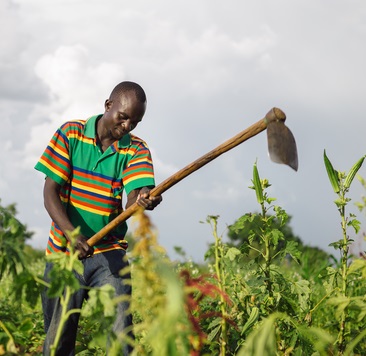
Wani Garanep’s family has managed to diversify their diets with vegetables after participating in FCA’s livelihoods training. Photo: Tatu Blomqvist
However, because of slashed food rations, the family has been forced to cut their daily meals from two to one. This goes for most of Bidibidi’s inhabitants.
”I would like to guarantee a good education for my children, but they can’t concentrate in school when they’re hungry, and they often come home before the school day is over,” says Garanep.
Garanep is a builder by trade. In South Sudan, he cut down trees and sold them as building material. The family could afford to eat meat.
Rose worked as a teacher, and the family had no shortage of food.
The hometown she left behind, Kajo Keji, was located in Equatoria, the breadbasket of South Sudan, known for its fertile soil. Before the war, the region was able to feed millions of people. Rose’s family had goats and chickens.
”When the children were hungry, they would pick fruit or cassava from our garden,” she says.
However, Kajo Keji is empty. Three quarters of the population of Equatoria have left their homes and Northwest Uganda is like one big refugee settlement that it takes hours to drive through.
Here, Garanep and Rose find it hard to find work with which to improve their families’ situation.
”Sometimes when the children are really hungry, they ask me ’mom, can’t we go back home to South Sudan so that we could eat.’ It’s hard to explain to them that there is still a war going on there,” continues Rose.
Life as a single parent is tough
After the meal, things get more active in the yard. With 13-year-old Gire and 9-year-old Diko in the lead, the children dig out a skipping rope. With great enthusiasm, Ayite counts her skips in English. This makes her mother happy.
They are more eager than usual because there are visitors, she explains. When the children are quiet and too tired to play, it is time to worry, she says.
Gire and Diko are not Rose’s own children, but after their flight together, they sleep together with Rose’s children.
”Sometimes they ask me where their mother is. Once the war is over, we will return to look for her.”
Life as a single parent is especially hard in the refugee settlement. Over 60 percent of the refugees in Uganda are under 18 years old, and most of the adults are women. When women and children fled, men took part in the fights – some forced, others voluntarily – or died in the conflicts.
In Rose’s yard, it is evident that she has to keep an eye on more than a dozen children, with barely no other parents in sight. Rose often worries about how long she will manage if the situation is prolonged.
”I miss my husband. I don’t know whether he’s alive or dead. I haven’t heard from him since we had to run away,” she says.
During the interview, Rose mends the trousers of her youngest child, 3-year-old Wani. They have to be taken in at the waist once again. Rose is most worried about 10-year-old Ayite, who has gone down from 25 kilos a year ago to just 19 kilos.
Being underweight makes Ayite vulnerable to disease and malnutrition.
”If she loses more weight, I might even lose her,” says Rose.
Text: Erik Nyström, photos: Tatu Blomqvist
This year, 60 percent of the funds collected in the Common Responsibility Campaign are directed to the Finn Church Aid disaster fund. Read more about FCA in Uganda here.
On 1 December 2017, the United Nations Office of Prevention of Genocide and the Responsibility to Protect and the Peacemakers Network signed a memorandum of understanding (MoU). As per the MoU, Convener and Executive Director of the Network, Mr. Antti Pentikäinen, and Director, Dr. Mohamed Elsanousi, will serve as advisors to United Nations Under Secretary-General and Special Adviser on the Prevention of Genocide Mr. Adama Dieng. The role will focus on the implementation of the Plan of Action for Religious Leaders to Prevent Incitement to Violence that Could Lead to Atrocity Crimes.
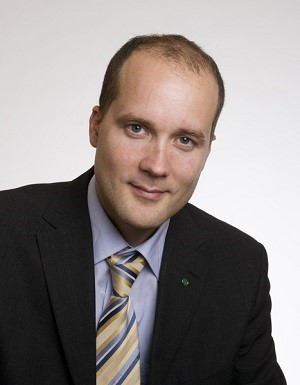
Antti Pentikäinen.
“Religion is repeatedly used to spread hate and violence. Despite this, religion also has the potential of acting as a source of strength for communities as they seek to find tools for coexistence and reconciliation. Our responsibility is to support the United Nations and the communities healing from violence in utilizing religion and religious actors as a source for positive change”, Mr. Pentikäinen said as describing his new role. Mr. Pentikäinen spoke of his new task at Capitol Hill in his opening remarks at the International Religious Freedom Roundtable.
The Office of Prevention of Genocide and Atrocity Crimes was established in 2004 after the genocides in Srebrenica and Rwanda to:
- Collect existing information, in particular from within the United Nations system, on massive and serious violations of human rights and international humanitarian law of ethnic and racial origin that, if not prevented or halted, might lead to genocide;
- Act as a mechanism of early warning to the Secretary-General, and through him to the Security Council, by bringing to their attention situations that could potentially result in genocide;
- Make recommendations to the Security Council, through the Secretary-General, on actions to prevent or halt genocide; and
- Liaise with the United Nations system on activities for the prevention of genocide and work to enhance the United Nations’ capacity to analyze and manage information regarding genocide or related crimes.
In 2015 the Office on Genocide Prevention and the Responsibility to Protect launched the so-called Fez Process, a two-year process of consultations with religious leaders and actors, supported by Member States, United Nations partners and civil society, led by Mr. Dieng. The Fez process resulted in the Plan of Action for Religious Leaders and Actors to Prevent Incitement to Violence that Could Lead to Atrocity Crimes, which was launched in July 2017 in New York by United Nations Secretary-General António Guterres. The Plan of Action was developed with the support of Network for Religious and Traditional Peacemakers, KAICIID Dialogue Center and World Council of Churches.
“I am very appreciative for the contribution the Network of Religious and Traditional Peacemakers provided to the development of the Plan of Action. The Network provided advice and support throughout the process. I am also particularly thankful to the Network as it had the courage to share my conviction – that at the heart of all religions is the belief in our common humanity and respect for ‘the other’. Together we have succeeded in placing a discussion about the positive power of religion at the heart of the work of the United Nations. I consider this to be a huge achievement,” Mr. Dieng stated during his visit to Finland in September 2017
The appointments will not affect Mr. Pentikäinen and Dr. Elsanousi’s role in the Network of Religious and Traditional Peacemakers.
For more information:
Antti Pentikäinen
antti.pentikainen@peacemakersnetwork.org
Further information:
UN Office on Genocide Prevention: www.un.org/en/genocideprevention
The Plan of Action for Religious Leaders and Actors to Prevent Incitement to Violence that Could Lead to Atrocity Crimes
The full speech by Mr. Adama Dieng at the 70th anniversary celebration of FCA
Examples of collaboration between the Pecemakers Network and the UN Office on the Prevention of Genocide
peacemakersnetwork.org
Safe schools and competent teachers are key in determining the future of the Central African Republic. The work of Finn Church Aid has encouraged local children and young people to return to school.
Squeals can be heard from a distance at the yard of Sangha school. It is recess, and the air is thick with red sand, with a group of boys running after a football turned yellow by the sun.
In the white classroom, little wooden desks are placed close to one another. The classroom can seat 150 pupils. The ones who do not fit in are left to peer in through the window. At the start of the school day, the number of pupils present for the day is marked in the upper corner of the chalkboard.
Although the school is crowded, it is in better condition than it was two years ago, when 14-year-old Christopher Tindo started at the school.
”The school was missing doors, windows and benches. They had all been stolen or broken. Now we can leave our books at school and lock the door, and no one can get in to take our things,” says Christopher.
Conflict took the doors from the school
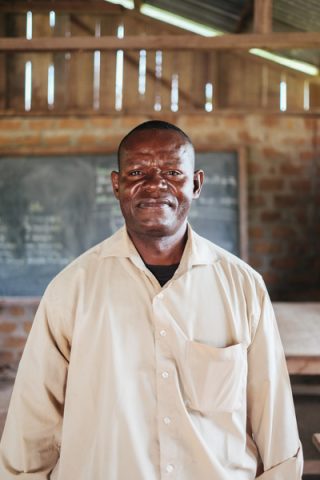
Jean Lessene thinks the most important function of a school is to teach how to live in peace.
The history of the Central African Republic is mottled with bloody tyranny and coups. In 2013, the situation turned violent, when the Séléka group consisting mostly of Muslims seized power, and the mainly Christian Anti-balaka groups rose to fight it.
The armed groups used school as bases because of their central locations. Most schools have been damaged or completely destroyed in the conflict. Education sector head Jean Lessene from Bayanga subprefecture says that armed groups took anything that could be used for firewood, up to the roof and the desks, and looted anything that was the least bit useful.
Families fled to the jungle, to farther-off villages, or across the border to neighbouring countries. Many children have not dared return to school.
Authorities, Finn Church Aid (FCA) and churches have campaigned together to get the children to return. The work has garnered resuts, and in many schools the number of pupils has doubled.
”Before the war, Muslims and Christians lived and went to school together. During the fights, Muslims fled, and some of them still have not dared return. We hope they come back,” says Lessene.
Educating teachers has enormous importance
Not all teachers have returned, either. Educated people either flee or seek better-paid employment. The ones left are less educated teachers and volunteers.
In Bayanga, out of the 43 teachers in the schools only five had gone through the official teacher training. Now, FCA has trained 17 teachers and pays them a small fee. Many of them had no prior experience of teaching.
”Thanks to the FCA training and teaching materials, they are now able to teach the children better. Without this support, education would not matter much around here,” says Jean Lessene.
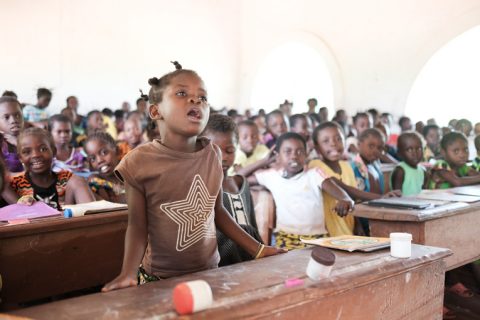
The competition for a turn to answer a question is fierce, with up to 150 pupils per class.
Geography without maps
The wall is high, and shards of glass glitter on top of it. No one will climb over this wall to the FCA regional office in the city of Berbérati in a hurry. Walls like this are a common sight in Central Africa. The situation remains unstable.
Over 63,000 children got to go to school
Central African Republic is one of the poorest countries in the world. In 2017, it was named the third most fragile nation after South Sudan and Somalia.
Nearly half of the population (2,2 million) is in need of humanitarian aid. According to UN estimates, almost half a million citizens of the Central African Republic are refugees in neighbouring Chad, Cameroon and the Democratic Republic of the Congo.
Finn Church Aid opened a country office in the capital Bangui in autumn 2013, and has worked in the midst of the Central African chaos ever since. FCA provides humanitarian aid to those in the most acute need, supports the development of education in the middle of conflict, and helps communities prevent and settle conflicts.
In 2016, more than 63,000 children benefitted from FCA’s education projects in the Central African Republic.
However, the gate is now opened, as a lorry backs to the yard. Kofi Ayisa is satisfied, school supplies are finally delivered. The lorry is filled with books, notebooks and pencils.
The delivery is a few days late, because the lorry got stuck in mud a couple of times during the journey. The rainy season is beginning, and the roads are a muddy mess.
”We are working in the parts of Africa that are the hardest to reach. More than once we have got stuck while on the road, and we have been forced to sleep in the car, in the middle of the jungle, pestered by mosquitoes,” says Ayisa from Togo, in charge of the FCA regional office in the city of Berbérati.
In rural Central Africa, getting around is very difficult. When FCA employees leave the Berbérati regional office for the village of Nola 150 kilometres away, the journey is estimated to take five hours.
”And this is a road in fairly good condition. We go to places that most organisations do not go. In many places, we are the only aid organisation. Someone needs to do this job, and FCA will be there. The challenges are big, but you have to start from somewhere.”
Despite diamonds, gold and other natural resources, Central African Republic is one of the poorest and most underdeveloped nations in the world. Berbérati is the nation’s third-biggest city but lacks running water and electricity.
In rural areas, there is also an enormous need for school supplies. It is common, for example, for geography to be taught without maps. The children cannot locate their own village on a map, let alone Central African Republic or its neighbouring countries.
”These children are supposed to go to university without ever having seen a map or a microscope – and they are meant to become doctors and decision-makers!” says Ayisa.
School teaches forgiveness
Despite difficulties, school brings stability to everyday life and and creates hope for the future. In Central Africa, the eagerness of the students gives hope.
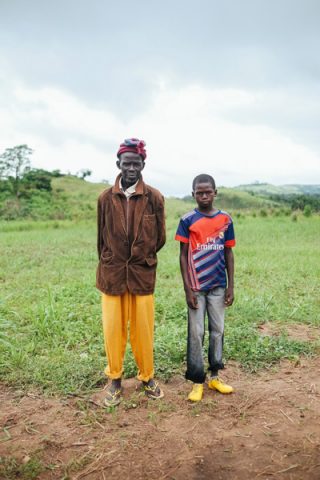
Christopher Tindo’s favourite thing about school is peace education. Grandfather Aobimou Nzerebaile
encourages the boy to study.
14-year-old Christopher studies hard. If he does not understand the subject of the lesson, he spends recess indoors going over it again. He dreams of becoming a teacher.
Head of the education sector Jean Lessene thinks that at its best, school can bring society together.
”The most important things that school can teach are the significance of peace and social unity,” says Lessene.
”Getting children back to school is a job for the entire society – the village community, parents and the government. It is the only way to guarantee a better future for this country.”
Christopher’s favourite subject at school is peace education. It involves the teacher talking about peace, living together, forgiveness and reconciliation.
“Peace is very important, and everyone should cherish forgiveness, love and joy everywhere in their own countries,” explains Christopher.
Text: Noora Jussila
Photos: Tatu Blomqvist
New bombings killed dozens of people and shook the sense of security in the Somalian capital.
Mogadishu had not had time to fully recover from the devastating bombing of two weeks ago, when several new explosions took place in the city centre. Dozens of people were killed and injured in last Saturday’s bombings.
On Monday, moving in the Somalian capital was impeded by a number of roadblocks. The fresh strikes are on everybody’s lips, because it has been a long time since strikes have taken place this close to the city centre and in such rapid succession.
“People in the city are in shock. Before the strike two weeks ago, many said that the sense of security in Mogadishu has improved and that the city has moved forward. Now they have had to take these words back,” says FCA Country Director Mika Jokivuori from Mogadishu.
One of those killed in last Saturday’s strikes was a close associate to FCA, interior minister of Southwest state, who had a key role in FCA’s local administration development project. Jokivuori last met the minister two weeks ago, after the first bombing that claimed over 300 lives.
“We held a moment of silence for the victims of the bombing, but talk soon turned to the future and to the development of Somalian local administration. His death is a great loss to us,” says Jokivuori.
FCA supports the construction of both central and local administration in Somalia. After decades of war and turmoil, local administration plays an important part.
“It is important for people to see how democracy works and how it affects their everyday life, and that administration is not just something distant in Mogadishu.”
The bombing two weeks ago also killed a relative of a local FCA employee, and people close to a few others were injured.
“Many employees send a text message when leaving the office, so that those at home know to wait for them. Many people’s sense of security has been shaken,” says Jokivuori.
Ten years ago, Finn Church Aid made a turnaround that allowed us to help more people than before. In honour of our 70th anniversary, we look back on key decisions.
Finn Church Aid (FCA) is the biggest development cooperation organisation and the second biggest provider of humanitarian assistance in Finland. Over the past ten years, its activities have expanded enormously. This is thanks to decisions made ten years ago, when then-Executive Director Antti Pentikäinen took charge.
FCA had long been engaged in development cooperation, mainly by funding projects carried out by partner organisations. However, Pentikäinen considered it important that FCA take responsibility for the results of its work. FCA sent its first aid workers out into the world and soon started to found its first field offices in Africa, out of which it started to carry out its projects.
The work was concentrated on three main themes: education, subsistence, and peace. The FCA workers already had a lot of expertise on education and subsistence. The work on peace was a new theme brought in by Pentikäinen, former advisor of Nobel Peace Prize laureate Martti Ahtisaari.
In peace work, FCA specialised on working with religious and traditional parties. The first target was Somalia, where efforts soon proved fruitful.
”Somalia then was like Syria today. Nobody wanted to go there, and the work was very dangerous. However, we have been able to help Somalia in many crucial turns,” says Pentikäinen.
”The key thing when doing peace work is not to give up and to learn from one’s mistakes.”
Work where others do not go
Another key decision has been to boldly go where others do not want to or cannot go. At the moment, FCA works in the three most fragile countries in the world: South Sudan, Somalia, and the Central African Republic. In closed-off Eritrea, FCA is one of few non-governmental organisations.
”For a small organisation, it doesn’t make sense to go to places with lots of operating parties. In the most fragile countries we get the biggest value for our work,” says interim Executive Director of FCA Jouni Hemberg.
Over the years, countries of operation have changed. State cuts in funding for development cooperation forced FCA to discontinue its work in South American countries. Nowadays, FCA operates in 15 countries, with many of its employees working in the countries of operation. FCA also cooperates closely with local organisations and authorities. The majority of FCA employees are local.
”Their local knowledge is valuable to us. At the same time, our projects are better rooted into local communities and some of the know-how stays there,” says Head of Humanitarian Assistance Eija Alajarva.
Swift help in catastrophes
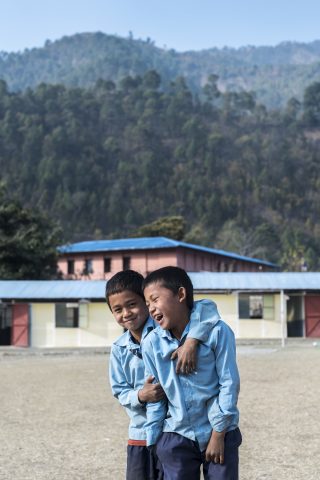
After the 2015 earthquakes in Nepal, more than 44,000 children got to study in schools and temporary classrooms built by FCA. Photo: Johanna Erjonsalo.
Alongside long-term development cooperation, FCA has become a swift provider of humanitarian assistance in catastrophes and conflicts. A turning point was the powerful earthquake in January 2010 that caused over half of the houses in poor Haiti to collapse. More than 220,000 people died.
During earlier natural disasters, FCA had supported aid work by funding organisations operating in the area or other members of the ACT Alliance of church aid organisations. However, the destruction in Haiti was massive, and there was a shortage of education personnel.
FCA took action. First, students were provided with temporary school tents, then temporary classrooms, and finally permanent schoolhouses. However, it was clear from the beginning that more than walls was needed, says FCA education expert Minna Peltola.
”We also wanted to improve the quality of education,” she says.
After the earthquake in Nepal in 2015, one lorry was used to transport material for building a school, teaching material, and a Finnish teacher who told local colleagues of dealing with the difficult experiences caused by the catastrophe. Schools and people were mended at the same time.
The results reached in education are impressive. After the 2015 earthquake in Nepal, FCA rebuilt 300 schools, more than any other organisation. In 2016, a total of over 132,500 children received high-quality education thanks to the work of FCA.
According to Peltola, it is important to invest in the quality of education in the future as well.
”A particular challenge is posed by fragile regions. For example, in South Sudan there is both a violent conflict and a food crisis underway. Young people are very vulnerable, and emotional support must be incorporated into all education.”
The aim now is to reinforce the connection between education and subsistence. There are more refugees in the world than ever after World War II. It is important for the people on the move not to drop out of school and for official degree diplomas to be handed out for their studies, helping them to secure a job and a new life.
FCA has organised degree programmes in Ugandan refugee settlements, with most of the first classes securing employment well. In Cambodia, FCA cooperated with the local Ministry of Education to develop the first student guidance system in the country and educated the first student counsellors.
An internationally respected aid organisation
70 years of aid delivered
Finn Church Aid was founded 70 years ago to channel aid from churches in the United States, Germany, and Sweden to war-battered Finland. After the years of rebuilding, both Finland and the Lutheran church in Finland slowly grew from recipients to providers of aid.
In the 1960s, the wars in Vietnam and Biafra increased the solidarity of Western youth in particular toward the so-called third world, and even in Finland, support grew for the work of FCA. In the late 1960s, the FCA budget grew thanks to the Common Responsibility Campaign fund drive.
As the Finnish church has traditionally been close to many African countries, development cooperation concentrated on these countries in its early years. In the 1970s, FCA e.g. aided the studies of Namibian students in Finland with a scholarship programme.
A new stage in aid work began in the late 1980s, as the Soviet Union loosened its legislation on religion, and churches in the Baltic countries and in Ingria were allowed to commence the formerly forbidden youth and Sunday school work and diaconal work. The region became the focus of FCA’s aid work, educating parish employees, repairing churches, and building church halls.
Finn Church Aid became an independent foundation in 1995. Over the past ten years, the Finn Church Aid personnel has grown from about 40 to nearly 400, and FCA has become the biggest development cooperation organisation and the second biggest provider of humanitarian assistance in Finland.
Thanks to brave decisions, the work of FCA has garnered a lot of respect internationally. More and more international sponsors have faith in the quality of FCA’s work.
In 2013, the UN asked FCA to found the Network for Religious and Traditional Peacemakers, and in 2017, FCA was invited to the steering group of international education expert network INEE. In INEE, FCA develops education in emergencies in cooperation with Unicef, Unesco, and other giants of the branch.
”I think not everybody understands yet how much trust the UN, for example, places in FCA’s know-how on negotiating with tribes and religious groups,” says Antti Pentikäinen, currently on leave of absence from his work as Executive Director of FCA, and leader of the Network for Religious and Traditional Peacemakers in New York.
”A small Finnish organisation has been invited to renew the practices of the entire UN.”
In recent years, FCA has worked to find innovative new ways to help people. In Greece, for example, thousands of refugees live not in camps but in metropols like Athens.
To reach young refugees, coding workshops were devised, in which young refugees learn the basics of coding and image editing together with young Greeks. At the same time, they get to know each other and become friends, and the gap between cultures is bridged.
In the future, conflicts become more and more diverse and challenging. Climate change will increase extreme weather phenomena, which in turn increase the risk of natural disasters in many countries. Because of the changes, a record number of people have already been forced to leave their homes.
”I’m proud of the church and the Finnish people having an aid organisation that takes responsibility for the real problems of the present moment,” says Pentikäinen.
Text: Noora Jussila
Violent attacks are increasing in the Central African Republic. The situation has thus far not affected Finn Church Aid’s work in one of the world’s poorest and most fragile countries.
United Nations (UN) humanitarian officials warned about an increasing number of violent acts in the Central Africa Republic (CAR) in July. According to the UN, the attacks are increasingly targeting children. There are concerns that humanitarian needs in CAR will escalate to levels previously reached four years ago when the conflict was at its worst.
According to FCA’s country director Katja José, the security situation has worsened especially in the northern part of the country, where armed groups have stopped humanitarian convoys twice during the past couple of weeks, robbing their aid items. Similar incidents have previously been reported from the eastern parts. Earlier this week, the International Federation of the Red Cross and Red Crescent Societies confirmed that six of its volunteers were killed there.
Humanitarian organizations have condemned the attacks and pleaded to the government of CAR and to the UN to secure humanitarian access. An estimated 2,2 million people in CAR rely on humanitarian aid.
“Should the humanitarian assistance stop, the civilian population will be most affected. Then they are forced to survive without food aid, medicines, hygiene products or school items,” José says.
No future without education
FCA established a country office in CAR in 2013. The work is focused on renovating schools that have been damaged by the conflict, delivering school kits and training teachers in and around Bangui and the southwestern parts of the country.
“The villages of Berberati and Nola, where FCA has its sub-offices, have for now been among the safest of regions and we have been able to continue our operations as per usual. Last week we had to cancel a meeting with local officials in Bangui because of the security situation.”
Renewed fighting has forced more than 150 000 people to flee their homes in the first half of 2017.
“There are a lot of children living in the refugee camps in CAR, who have been separated from their families. Many women have lost their husbands and are now single parents.”
The need for development cooperation is dire even in the midst of the conflict.
“In conflicts, education is often overrun by other needs, but if a generation grows without the possibility of going to school and receiving education, do they have a future? Education is a human right and everyone should commit to guaranteeing children the right to education.”
José moved to CAR two months ago. She has previously worked for different NGO´s in Mozambique, Tanzania and Zambia.
“CAR is clearly poorer than countries that have enjoyed peace for a longer time. In the beginning of 2000, Zambia and Mozambique were among the poorest of countries, but now both are better off than CAR. I believe that the reason for this is that the people have been able to go to school, farm their land and go to work – and these are the things that many people can’t do in CAR because of the fighting.”











